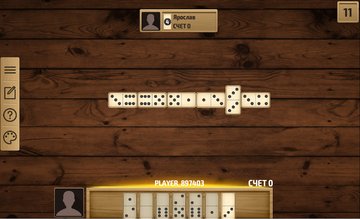Domino Mod Apk 3.3.9 Description:
Introduction to Dominoes
Dominoes is a classic board game known for its engaging gameplay and strategic depth. The game is played with rectangular tiles, often referred to as "dominoes." There exists a rich variety of games that can be played using these tiles, making it a versatile gaming option for players of all ages. Each game variant comes with its own unique set of rules, strategies, and objectives, offering a delightful way to challenge oneself against friends or formidable AI opponents.
Diverse Game Variants
In the world of dominoes, there are at least ten exciting variations that players can explore. These include classic games such as the draw game, block game, muggins (or All fives), and more niche options like Mexican Train, Naval Kozel, Jackass, Human-Human-Wolf, Kozel, Bergen, and Cross. Each of these games adds a new layer of complexity and enjoyment, requiring players to adapt their strategies and approaches. The inclusion of popular upcoming games such as Chicken Foot and Blitz in future updates ensures that the gameplay experience remains fresh and engaging.
Multiplayer Fun and Daily Challenges
For those who thrive on competition, three different online multiplayer options are available: the draw game, block game, and muggins. Players can connect with friends or compete with others across the globe, testing their skills and strategizing to come out on top. Additionally, players can engage in daily challenges to earn bonuses, providing a wonderful incentive to return to the game each day.
Number of Players and User Interface
Dominoes is designed to be a friendly and accessible game for 2 to 4 players. The user interface is intuitive, ensuring that both seasoned players and beginners can quickly learn how to navigate the game. Smart AI opponents present a challenging experience for solo players who wish to refine their skills or play without the need for online matchmaking.
Global Leaderboard and Player Statistics
To excite competitive spirits further, a global cloud leaderboard allows players to compare their performance against others worldwide. The game's comprehensive single-player statistics provide insights into personal progress, helping players track their improvements and achievements over time.
Understanding Domino Sets
A typical set of dominoes, also called a deck or pack, contains 28 pieces known as bones or tiles. Each domino is divided into two square ends, each marked with a number of spots or left blank. The traditional domino set follows a Sino-European design, which has been the foundation for numerous games worldwide. Players commonly refer to ends of dominoes as pips, and their varying configurations are what make the game so interesting.
For more complex games, extended sets such as the double 9 and double 12 can be used, allowing players to explore a broader array of gameplay possibilities, especially in games like Mexican Train and Chicken Foot.
Cultural Variations in Gameplay
Dominoes has a wonderful cultural history, with each country adopting its own preferred games and unique styles. For instance, players in England enjoy muggins, while Scandinavian countries favor Bergen. In Mexico, players have embraced Mexican Train, and Spain has its own version called Matador. This variety reflects how diverse playing styles and rules have evolved in different regions, enriching the overall experience of dominoes.
The Basics of Play: Blocking Game
The blocking game is a foundational variant of dominoes and is typically played by two players using a standard double-six set. The game starts with tiles shuffled face down, forming a stock or boneyard. Each player draws seven tiles from the stock, and the rest are set aside for future use. Tiles are placed upright, allowing players to see their own pieces while keeping their opponents' hands concealed.
A player initiates the game by placing a tile from their hand onto the playing surface. The first tile can vary based on the specific rules of the variant being played; for example, in muggins, the highest double (6-6) must be played, while in Bergen, the first move is 0-0. Players take turns adding tiles that match the exposed ends of the current layout. The game continues until one participant successfully places their last tile, thus winning the game, or until the game becomes blocked. If a block occurs, the player who caused the blockage collects points based on the remaining tiles in the opponents’ hands.
Scoring Dynamics
Scoring in dominoes is intricate and varied among the different game types. In scoring variants, players have opportunities to earn points during play based on specific configurations or by emptying their tile hands. Muggins (All fives) requires players to create sums of 5 or its multiples at the ends of the layout, while in Bergen, points are scored when the numbers on both ends are equal. In cases of missed opportunities, there are penalties; for instance, if a player forgets to call "domino" before playing their tile, they may incur an additional tile from the boneyard if another player claims it after the placement.
The Draw Game Explained
In draw games, players have the flexibility to draw tiles from the stock, which adds an extra layer of strategy. Players can continue drawing until they feel confident enough to play a tile or strategically choose their moves based on remaining tiles in their hands or the stock. Typically, at least two tiles should be held in the stock for optimal play. The draw game is so popular that it is often simply referred to as "dominos."
The Arrival of Mexican Train
One of the most exciting elements within the game is the inclusion of Mexican Train, a variant that promises to bring new strategies and player interactions. With its accessible rules and engaging playstyle, Mexican Train is perfect for both new and experienced players alike. Its addition to both the offline and online game modes ensures that players can enjoy this dynamic variant whenever they desire.
Embrace the world of dominoes as you explore a variety of game types, challenge friends, or pit your skills against global opponents while striving for the top of the leaderboard. Enjoy the thrill of this multifaceted board game, and may your strategies lead you to victory with every tile you play!
Domino V3.3.9 Mod Apk[No Ads] Features:
Overview of Domino MOD APK
Domino is a captivating game that takes players into the exciting world of this classic tile-based game. In its MOD APK version, players can enjoy enhanced features recently unlocked, providing a more immersive experience than ever before. This version has eliminated ads, allowing uninterrupted gameplay and keeping players focused on their strategic moves. Domino offers a blend of tradition and modern gaming elements, making it suitable for both casual players and seasoned enthusiasts.
Enhanced Gameplay Experience
With the Domino MOD APK, players will find themselves in a dynamic gaming environment where they face off against opponents with various skill levels. The elimination of ads means that players can engage fully in competitive rounds without distractions. The game mechanics are simple yet challenging, with players needing to match their tiles strategically to outwit their opponents. The joy of placing the perfect tile and blocking an opponent’s move adds depth to the game.
Unlimited Features
The MOD version of Domino comes with a plethora of features that enhance the overall gaming experience. Players can access unlimited chips, enabling them to play as much as they want without the fear of running out of essential resources. This feature is particularly appealing to those who enjoy playing for extended periods and wish to develop their skills without interruptions.
Diverse Game Modes
Domino offers various game modes catering to different player preferences. Whether you are looking for a casual game against friends or an intense competition with strangers worldwide, this MOD APK allows you to switch between modes effortlessly. Players can choose to play in a friendly setting or join tournaments for a chance to showcase their skills on a larger stage. The diverse game modes keep the gameplay fresh, ensuring that players always have something new to explore.
User-Friendly Interface
One of the standout features of the Domino MOD APK is its user-friendly interface. The game is designed to be intuitive, making it easy for newcomers to navigate while also providing advanced options for experienced players. Clear graphics and engaging animations enhance the visual appeal of the game, while the smooth controls ensure that every move is executed flawlessly. With the streamlined interface, players can focus on their strategy rather than getting bogged down by complex menus.
Challenging AI Opponents
For those who prefer solo play, the MOD APK version of Domino presents players with challenging AI opponents. These AIs are designed to mimic real players' strategies, providing a tough competition that tests various gameplay skills. Players will find themselves strategizing and adapting quickly to the AI's moves, making every match a personal challenge. The thrill of overcoming a challenging AI opponent adds a rewarding aspect to the gaming experience.
Online Multiplayer Mode
Connecting with other players is a significant aspect of the Domino experience. The MOD version allows users to engage with friends or challenge players from around the globe in online multiplayer mode. This feature brings a social element to the game, allowing players to build connections and foster friendships with fellow gamers. Competing with others can determine who has the best strategies and skills, leading to exciting matches filled with anticipation and thrill.
Regular Updates and Improvements
The developers of Domino are committed to providing a quality gaming experience, and the MOD APK version regularly receives updates to enhance gameplay, fix bugs, and introduce new features. This dedication to improvement ensures that players can always look forward to new content, keeping the game engaging and relevant over time. Regular updates help maintain the game’s vibrancy, allowing players to explore new strategies and methods while enjoying their favorite pastime.
Social Features and Community Building
The social aspects of Domino are enhanced in the MOD version, where players can easily connect with friends and share their achievements. The ability to challenge friends directly adds a competitive twist to friendly gatherings. Players can keep track of their performance statistics and share them with others, fostering a sense of community among the players. Engaging with fellow gamers through social features makes the experience not just about winning but also about celebrating victories together.
Skill Development
Playing Domino is not only about having fun but also an opportunity to develop and refine strategic thinking skills. The MOD APK version allows players to engage in various scenarios, helping players learn to anticipate opponents’ moves and develop strategies to counter them effectively. As players invest time in the game, they notice a significant improvement in their gameplay skills, which translates to success in competitive matches. Longevity of engagement is guaranteed as players continuously seek to improve their game.
Conclusion of Features
The Domino MOD APK version is a spectrum of opportunities presented in an invigorating format. The lack of ads allows for a seamless and enriched gaming experience, while features like unlimited chips, various game modes, and challenging AI opponents serve to keep players engaged. The game’s elegant design and user-friendly interface streamline gameplay, making it accessible for players of all skill levels. By joining the online multiplayer mode, players unlock new social dimensions to the game, while frequent updates put them in touch with the latest enhancements and challenges.
In essence, Domino MOD APK provides a comprehensive gaming experience that appeals to both casual players and hard-boiled strategists alike. The combination of traditional gameplay mechanics with modern enhancements propels players into a world filled with excitement, competition, and endless possibilities.

 Bonus Game
Bonus Game
























